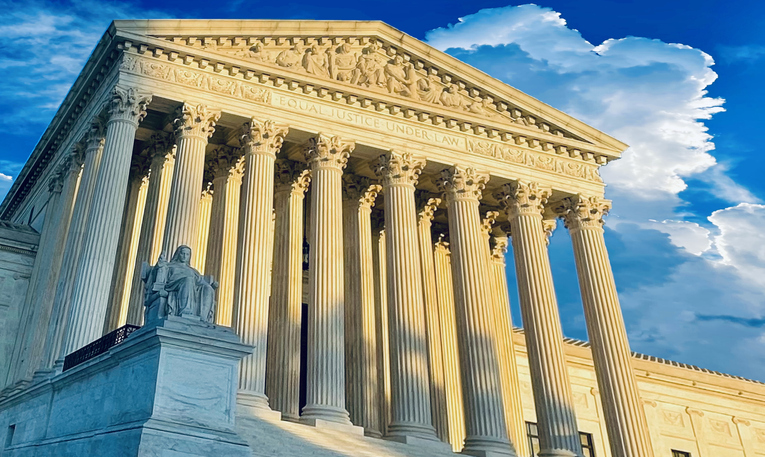 (Getty Images)
(Getty Images)
The United States Supreme Court declared on Thursday that the use of affirmative action admission policies used at Harvard University and the University of North Carolina were unconstitutional.
What Happened in Court?
According to USAToday, “the vote was 6-3 in the University of North Carolina case, with the court’s conservative wing lining up behind Roberts. Justice Ketanji Brown Jackson recused herself from the Harvard case, so that vote was 6-2.”
“Today’s decision sets us back more than four decades. For generations, affirmative action has been a powerful means of lowering barriers to education for historically marginalized and underrepresented students of color. At its core, it simply aims to remedy the government sanctioned, decades-long inequality in the college admissions process. … Dismantling these policies will not only have devastating implications for students of color, but for the classrooms at these institutions, which will become devoid of diversity in the experience and perspective needed to solve America’s toughest challenges. … As Judge Ketanji Brown Jackson said in her dissent, ‘deeming race irrelevant in law does not make it so in life.’ This decision is just another example of the far-right attempting to uphold white supremacy and classism in our institutions. We must fight to preserve policies that address racial inequality and use every tool at our disposal to advance equity in education. Ignoring race will not end racism,” U.S. Rep. Barbara Lee of California said in a statement.
What is Affirmative Action?
By definition is it, “the use of policies, legislation, programs, and procedures to improve the educational or employment opportunities of members of certain demographic groups (such as minority groups, women, and older people) as a remedy to the effects of long-standing discrimination against such groups,”
Affirmative action was implemented to help minorities and underrepresented groups gain equal opportunities when it comes to education and job access. In 1961, then President John F. Kennedy signed executive order 10925 which deemed it wrong to discriminate on employment applicants due to “race, creed, color or national origin.” Later, the federal government initiated affirmative action policies under the Civil Rights Act of 1964. Former President Lyndon B. Johnson’s executive was amended to the policy as we know it today, which includes that businesses could not discriminate against on the basis of “race, color, religion, sex, sexual orientation, gender identity or national origin.”
What Does it Have to Do With the 14th Amendment?
Chief Justice John Roberts stated that affirmative action violates “ the Equal Protection Clause of the Fourteenth Amendment.” The 14th amendment declares that all citizens have “equal protection under the law.”
If SCOTUS was serious about their ludicrous “colorblindness” claims, they would have abolished legacy admissions, aka affirmative action for the privileged.
70% of Harvard’s legacy applicants are white. SCOTUS didn’t touch that – which would have impacted them and their patrons.
— Alexandria Ocasio-Cortez (@AOC) June 29, 2023
How is the Public Taking It?
Due to the ruling of race not being a factor in admissions some feel that this would allow the admission process to be more colorblind, while others believe that this is just a way to discriminate more.
Don’t tell us that affirmative action is unfair when 36% of a single freshman class admitted to Harvard were legacy students.
Less than 11% of the same class were Black.
— Public Citizen (@Public_Citizen) June 29, 2023
Affirmative action never benefited Black people anyways 🤷🏾 we always had to to be overly qualified just to get paid less or looked over by our mediocre “white” counterparts pic.twitter.com/iikEZySSjm
— 2RawTooReal (@2RawTooReal) June 29, 2023
White privilege is thinking that affirmative action is an unfair advantage, instead of keeping the qualified from being unfairly disadvantaged or throwing out a qualified applicant because their name sounded to African American.
— Let Them Eat Cake Boss (@Kyla_Lacey) June 29, 2023
This is the face of a man who climbed the ladder of affirmative action to his present perch of power only to help destroy the very ladder on which he ascended. This is not only the mark of deep ingratitude & disavowal of history, but a withering betrayal of justice & democracy. pic.twitter.com/qtoLiOlQuy
— Michael Eric Dyson (@MichaelEDyson) June 29, 2023
What Is Next?
The removal of race from applications and affirmative action overall could disproportionately affect the way people of color are accepted into colleges and work spaces. In hopes to reach diversity goals, colleges and universities will promptly have to find alternative ways to boost and maintain equal opportunities and diversity, equity and inclusion on campus.
Ariyana Griffin is a graduate student at Morgan State University in Baltimore, Maryland. She is a California native and graduate of Clark Atlanta University. Follow her on Twitter: @Ariyanaaganee and Instagram: @ari.yana.g.
Edited by Nykeya Woods